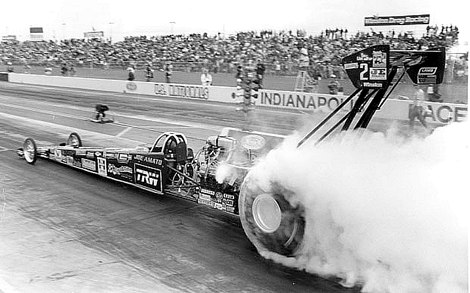 |
LOCK-UP CLUTCHES
One of the benefits of information retrieval such as that by the RacePak
people was the lock-up clutch. Armstrong, Bernstein's Budweiser King
crew chief, discovered from computer data that on all Funny Car (and
Top Fuel runs) the engine was turning at least 10-percent faster than
the clutch at all times during every run. This led to annoyances like
smoking rear tires at certain points of the run. The lock-up was a better
mousetrap in terms of controlling that. Armstrong contacted Tony & Lanny
Miglizzi of L&T Clutches and came up with a two-stage clutch that was
truly locked up in the final stage of every run. Tim Richards, Dave
Settles, and Bob Brooks of AFT soon came up with a three-stage lock-up,
and Austin Coil soon came up with a four-stage lock-up clutch, etc.,
etc., etc.
"Dale had Kenny's car in a Funny Car final at Bandimere Speedway
in 1986 and got beat when the tires lit up. My father and I knew Dale,
and he approached us and said something like, 'I've got this idea and
I've always wanted to try it,' and that idea was the lock-up clutch.
Dale knew the amount of clutch it needed to get the car down the track,
but the trick was initially how to get it off the line. He trusted us
to keep quiet because he wanted secrecy. If the idea of a lock-up got
out, it would, you know, take away any advantage he wanted to get on
the competition.
"That proved hard to do after what happened at Indianapolis in
1986 when we debuted the unit. Kenny pulls up against Roland Leong's
Hawaiian Punch Dodge, which shuts off on the line. Then Kenny blasts
off and runs Indy's (and the sport's) first 270-mph ru- 271.42. There
were a lot of racers watching that run and because Kenny was alone on
the track, they heard the car shift. They were smart, knew what they
had seen, and they really wanted that piece and really besieged us,
but we had a deal with Kenny and Dale not to go public with it until
the end of the year. But the long and short of it was that Dale Armstrong
got the lock-up clutch into drag racing. - Lanny Miglizzi
THE BIG REAR-STABILIZER WING

At the 1984 NHRA Gatornationals, Joe Amato shattered the 260-mph barrier
with runs of 260.11 and 262.39-mph while winning the race. The reason
he stepped up so much was the seven-foot plus high rear wing up and
behind the engine. Designed after meetings between Indy 500 designer
Eldon Rasmussen and Amato's crew chief Tim Richards, the wing increased
the down-pressure and stayed above the turbulence created by the engine
and the tires. It was quite a breakthrough given that the first 250
was run almost 10 years earlier.
"Timmy and Rasmussen both agreed that it was necessary to get
the rear wing, which was standard on all fuel dragsters, above the turbulence
of the engine and tires. Eldon had tons of experience in this area and
we went with him on it. Up until that time (the '84 Gators), the cars
had been trying to drive through that on the top end and they were stuck
in the mid 250s for 10 years. The thing I remember most was when we
made our first run, Timmy told me whatever you do, keep your hand on
that brake during the run because this baby might take off, like in
a wheelstand. First run was 259.36 mph and I felt we were on our way
and we were." - Joe Amato.
|
|
|
| |

Champion
is offering you the opportunity to be part of its winning team. This offer
is extended to competitors and members of the motorsports community who
use and support Champion ignition products.
This
membership includes:
Member
Discounts
Club Newsletter
Decals
Patches
Racing News
Results
We
are very interested in your competive results and your history with Champion
products, and welcome any submissions about these subjects.

|
|
|
|
|